Resources are the moving gears of an organization, and addressing resource management challenges is paramount to driving organizational success. Investing the right source of power into the right project is called resource management.
But is that all?
Is its execution as simple as it sounds? Definitely not!
From ensuring constant supervision to delivering quality products, resource management is a full job in itself. This, when done wrong, can set your efforts back to square one.
Human resources isn’t a thing we do. It’s the thing that runs our business. – Steve Wynn
Let’s explore some common resource management challenges and the practical ways to address and overcome them. However, the discussion is incomplete without speaking about its importance to the organization’s effectiveness.
A Free guide to help you with proven ways to lead a project from start to finish, without confusion or jargon.

Why is resource management important?
No business can succeed without effective project resource management.
When done right, you get ultimate control over not just your workforce but budget and workflow as well. With clear visibility into your resource schedule, availability, and capacity, you can make wise decisions to achieve the right resource utilization. Ultimately getting the most out of their efforts and skills while minimizing wastage.
7 Common resource management challenges and solutions
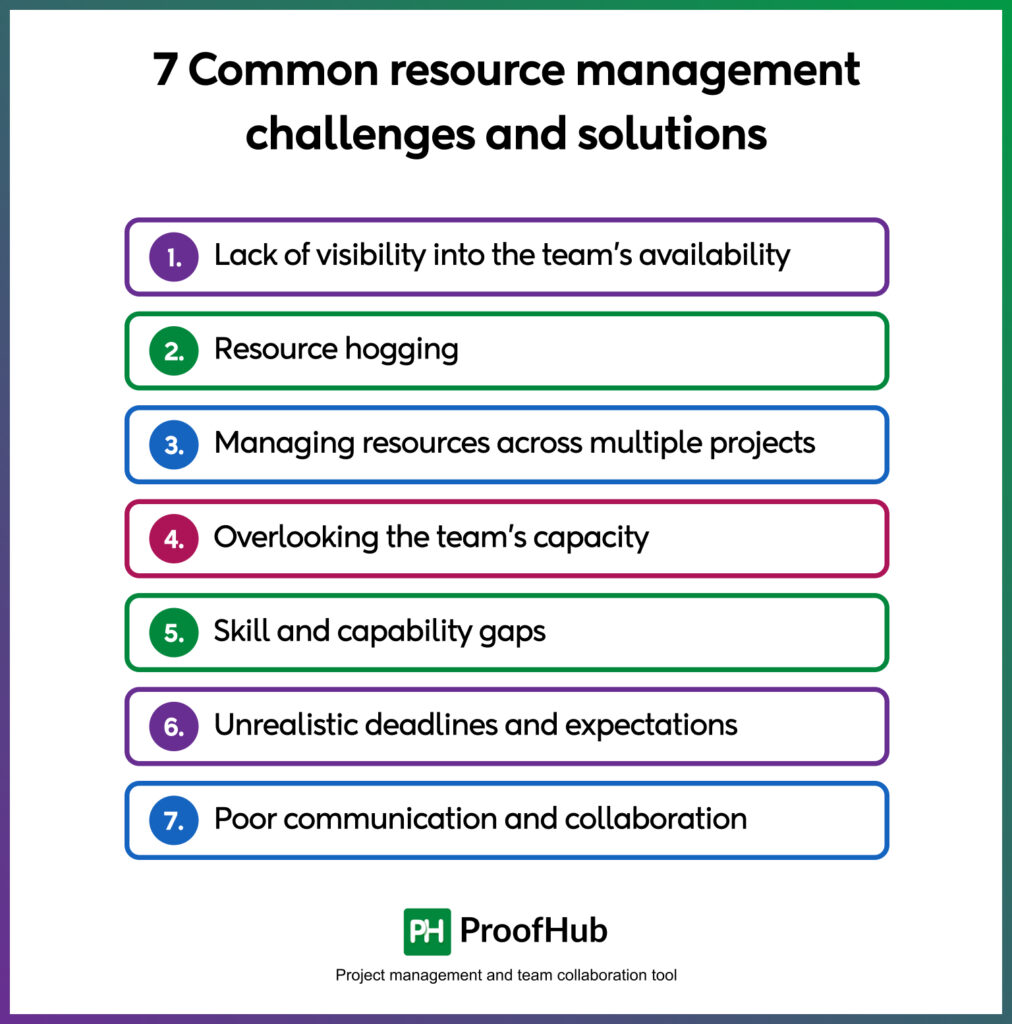
Here are some prominent resource management problems and the practical ways to deal with them upfront.
1. Lack of visibility into the team’s availability
According to a recent survey, 41% of survey participants cited visibility into the availability of resources as one of the most significant challenges in resource management.
If you are unaware of your resource capacity and their skill set, you are miserably going to fail at resource forecasting. That means you are unknowingly going to overload some team members’ plates while letting others play around idly. And the results? Missed deadlines, compromised quality, and an inefficient workflow. Such setbacks can take a toll on your decision abilities as a project manager.
The solution
The ultimate solution to eradicate this issue is to get yourself a centralized platform. This comprehensive database acts as a single source of truth, highlighting your resources’ availability, skills, and workload. Also, with its standardized interface, you can quickly have a glance into your team’s progress and performance even when on the go.
Stay on top of resource efficiency with ProofHub
ProofHub’s all-in-one platform elevates your resource management practices to the next level. It helps you get insights into your teams’ performance and track time using resource utilization reports. You can utilize this information to optimize between productive and not-so-productive hours.
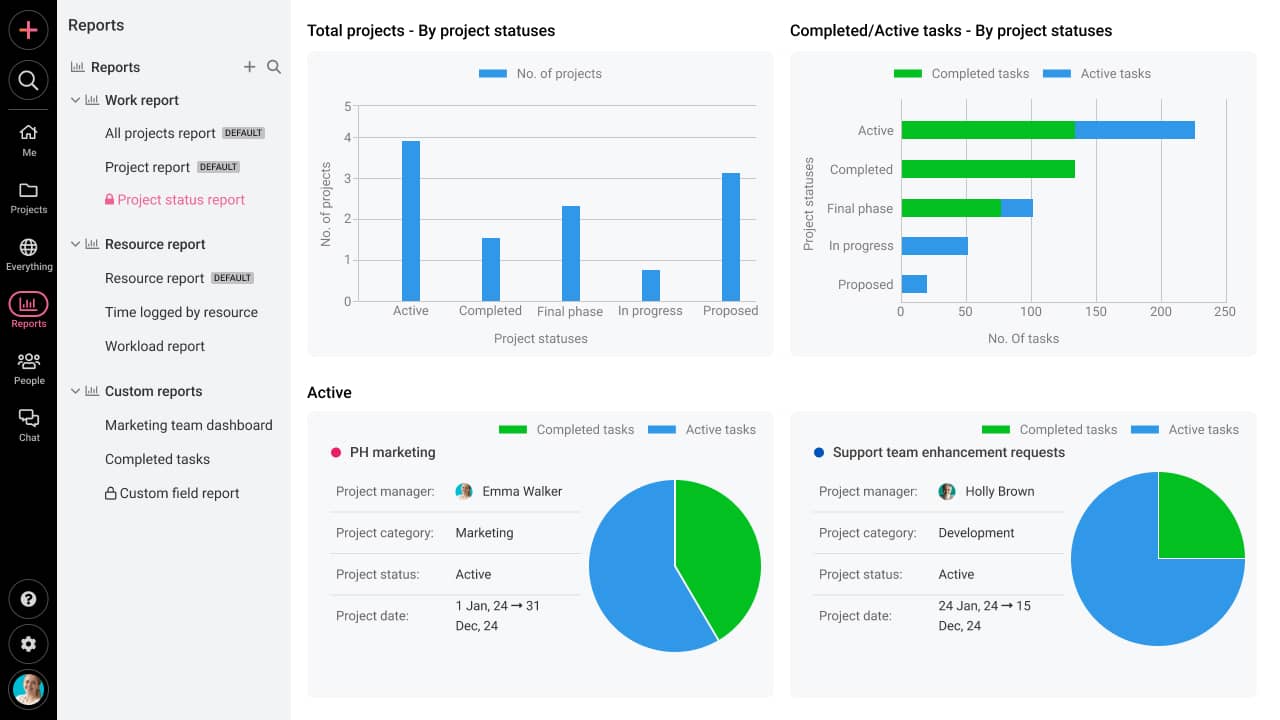
2. Resource hogging
Resource hogging is a problematic concept found in every organization where resources are involved. It is a phenomenon characterized by the needless blocking of shared resources, leaving others to deal with manpower shortages. This is one of the key resource management issues that can severely affect the flow of work.
Doing so intensifies the detrimental impact on project performances, team health, and morale, ultimately draining resource efficiency and productivity. Not only that, but this can even spark conflicts and frustration between PMs within the organization.
The solution
While you may feel tempted to keep resources solely at your disposal, ensure you retain the talent you need. Do not hoard them for ‘just in case’ scenarios. Design a strategic resource utilization plan to ensure equal distribution. Track the data regularly and intervene as soon as you see things taking a turn for the worse.
3. Managing resources across multiple projects
Organizations don’t work in an ideal world where the entire team is focused on one particular initiative. But that’s just not the case. Multiple projects run simultaneously, and the teams have to juggle the priorities. And that is just easier said than done.
Moreover, the situation worsens when the projects pile up, but the resource backup is limited. Every project seems important and urgent. In that case, you have to quickly evaluate which tasks should be prioritized. So that deadlines are met without causing burnout.
The solution
Learn the art of prioritization. Yes, that’s the key to keeping your resources running at their optimal efficiency. You need to play a strategic role in defining where you want your employees’ skills and capabilities to be utilized. For that, you need to have a clear understanding of your long-term goals and objectives. Ensure your priorities align with key objectives.
4. Overlooking the team’s capacity
Being a project manager, you can jeopardize project success if you fail to take into account the team’s capacity. Be it drowning someone completely underwater or providing others the bare minimum to float; poor resource planning is to blame.
Also, expecting resources to work at 100% of their capacity is the most prominent resource issue. Some managers tend to overlook the non-project tasks, including endless meetings, overloading email inboxes, and constant interruptions. These factors eat up a good amount of your manpower.
The solution
Ensure conducting regular resource assessments to analyze team workload and availability. This ensures you do not overload your team, hence avoiding burnout and decreased productivity. On the flip side, to ensure equal workload distribution, try to stay agile with shifting priorities, bottlenecks, and scope creep. Do not forget to leave some tasks for non-project tasks.
Try ProofHub’s workload reports to visualize work capacity
With ProofHub’s insightful workload reports, you can get insights into your team’s capacity by comparing their workload. You can allocate your teams the tasks based on who is working on what and how much work is on their plate.
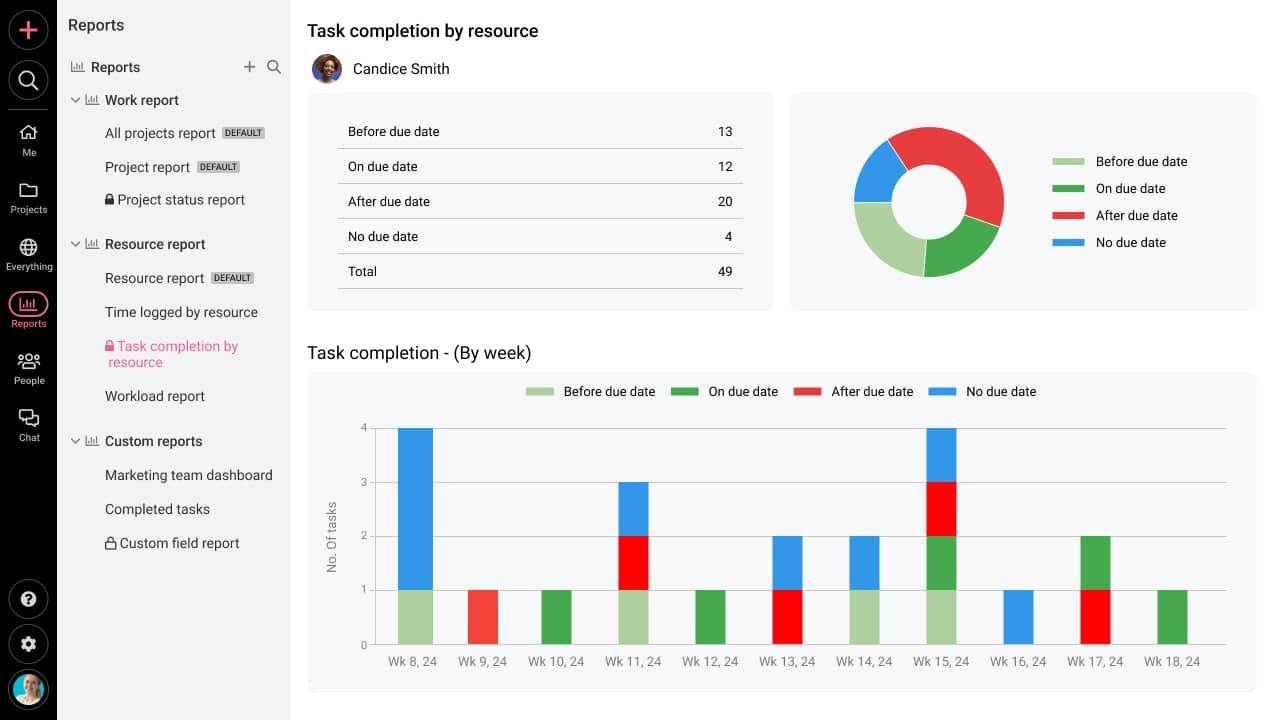
5. Skill and capability gaps
Having resources is not enough. Their skill set alignment with your project demands and company goals is equally crucial. If not addressed, this disparity manifests into project and organizational failure in the long run.
Changing project requirements and expertise shortages are some crucial factors that widen the capability gap. Also, employee turnover leaves the organization understaffed and disrupts project continuity. This resource scarcity may necessitate the need to look out for additional expertise and skill sets.
The solution
Invest in training and development initiatives and offer opportunities for upskilling, reskilling, and cross-training. This ensures employees are equipped to tackle evolving project demands. Also, foster a culture of collaboration to promote continuous learning. Provide regular and constructive feedback, helping employees shine through the lens of improvement.
6. Unrealistic deadlines and expectations
While setting deadlines provides a framework for task completion, unrealistic deadlines, and expectations are detrimental. It not only puts undue pressure on your teams but adversely impacts the quality of work. Because when teams rush to hit deadlines, the quality standards may get compromised and even lead to missed deliverables.
Although you may feel tempted to set a rough estimate for a task, practicing the same is not the right way of working. And creating such an environment where employees are expected to overextend is not a healthy way of working.
The solution
Ensuring your task deadlines are attainable and realistic is a matter of meticulous planning. Make a close inspection of all task priorities before putting on the dates, and also do not overlook dependencies. You can even add check-ins and milestones to foster a sense of achievement. Also, have regular meetings to avoid and eliminate bottlenecks from creeping in.
7. Poor communication and collaboration
Communication breakdown at the workplace is a pervasive issue that abruptly interrupts the consistent flow of operations. Resulting in constant errors, rising misunderstandings, and, worse, employee burnout. Also, with so many organizations transitioning to remote and hybrid setups, maintaining effective communication becomes even more challenging.
According to The State of Business Communication, sponsored by Grammarly, 50% of participants admitted that poor communication increases stress levels. On the other hand, 30% claimed to have lower professional confidence due to inefficient and ineffective communication at the workplace.
The solution
No organization likes to have an unmotivated employee base at their disposal. And to boost their morale and job satisfaction, your role as a leader remains unbeatable. Establish clear communication channels to ensure everyone is on the same page. While regular communication is crucial, nothing compares to having open and transparent communication.
Pro tip: You can use collaboration tools or project management software with a built-in chat to strengthen relationships with and within your teams.
Check out ProofHub’s real-time communication tool
ProofHub’s communication tool streamlines your communication in real-time. Its built-in chat enables theme members to slide into each others’ inboxes in no time. You can also use discussions to brainstorm, collect thoughts, and gain someone’s attention by mentioning them in the discussion space.
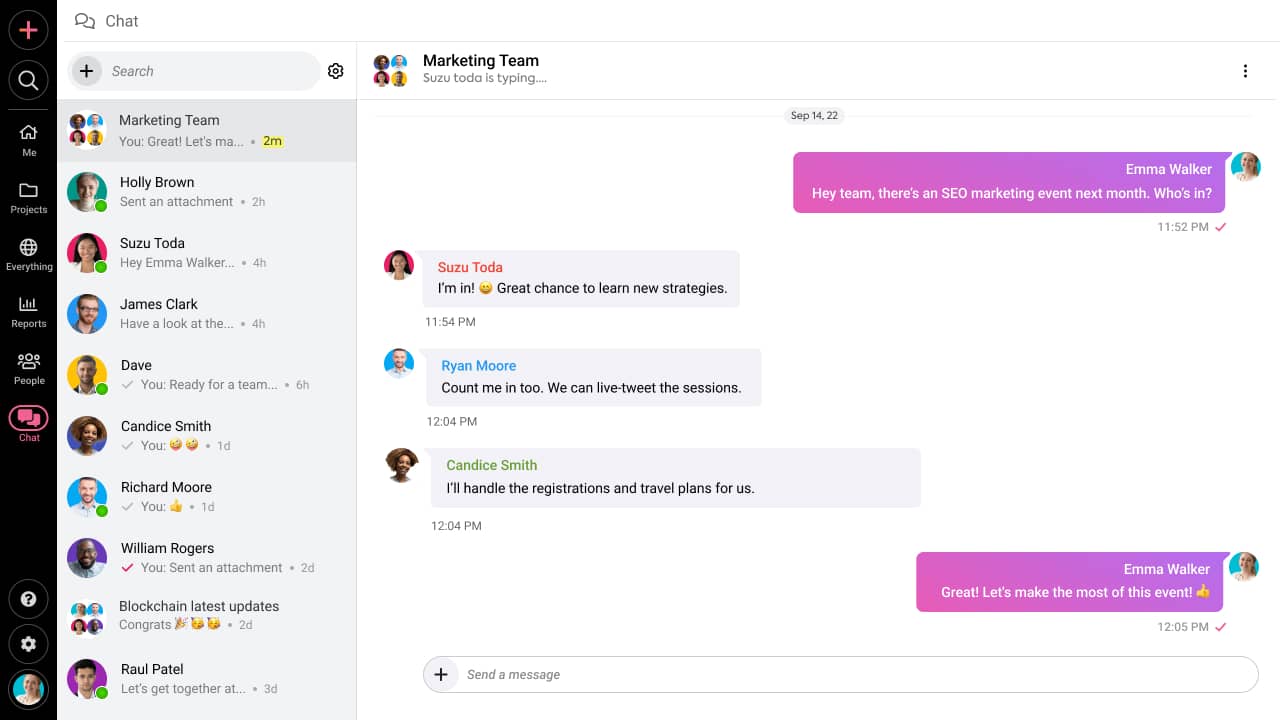
Benefits of optimizing resources
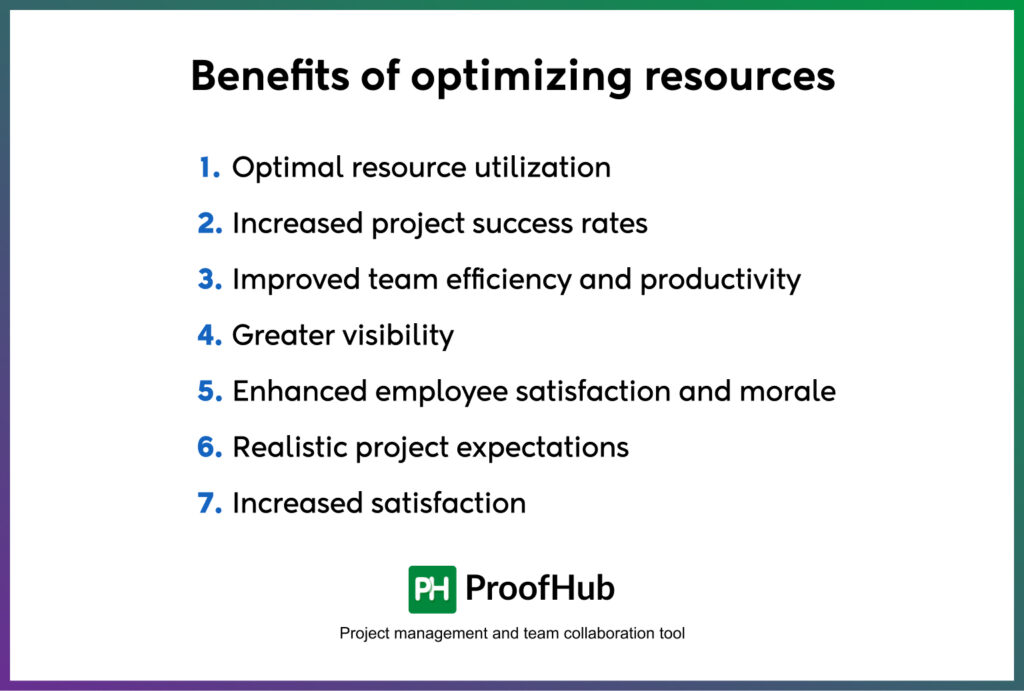
1. Optimal resource utilization
When you invest time into outlining your resource plan, you prevent the inefficiencies from plaguing your business operation. By allocating the right resources based on their skills and availability, you can save their efforts from going in vain.
2. Increased project success rates
Organizations that establish a clear blueprint of their process reap improved resource management capability benefits almost immediately. When productivity levels do not seep through the cracks, the deadlines are met with ensured project quality.
3. Improved team efficiency and productivity
When your decisions are data-driven, efficiency is reflected in your resource utilization plan. And by aligning project objectives with the right employee skill set, you empower your business practice. This leads to increased productivity across the teams.
4. Greater visibility
Effective resource management planning eliminates many resource challenges in project management. Despite hundreds of projects underway, you can get a bird’s eye view of your entire workflow. It helps managers make better decisions.
5. Enhanced employee satisfaction and morale
Right resource allocation results in happier employees. Employees feel frustrated and drained out when given mismatched and tons of work. But when you ensure equal workload distribution, performances enhance, and satisfaction flourishes.
6. Realistic project expectations
When you are aware of the limitations of your resources, you tend to set realistic expectations. But smart planning takes the guesswork out of the picture to provide a baseline for expectations.
7. Increased satisfaction
When end products are delivered on time without employees stretching out their work, satisfaction levels escalate. Teams feel confident in their abilities, and stakeholders feel content.
Conquering resource management challenges
From the crux of our entire discussion, it is evident that as a manager, you need to stay on your toes all the time. Strategic planning, being realistic, and prioritizing are the keys to avoiding resource management challenges. Be proactive in your approach to dealing with resource allocation.
Lastly, and most importantly, strive to be available for your team. While it may sound a little impossible to be ever-present, at least you can make an effort. When teams seek your assistance, lend them an ear and offer solutions to build a healthy and productive environment.

